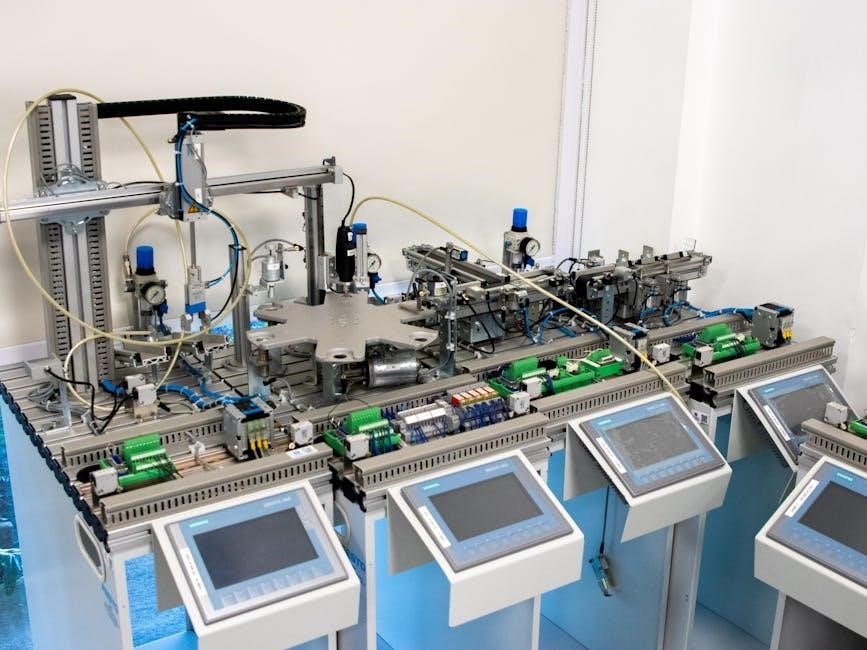This comprehensive guide provides detailed solutions for common issues with AMP Research Power Steps, offering step-by-step diagnostics and repair tips to ensure optimal performance and longevity.
Overview of AMP Research Power Steps
AMP Research Power Steps are automatic, electric-powered running boards designed to enhance vehicle accessibility and convenience. They extend when doors open and retract when closed, providing a sturdy step for easy entry and exit. Built for durability, these steps are constructed with high-quality materials and are compatible with various vehicle makes and models. Their sleek design integrates seamlessly with your vehicle’s style while offering reliable performance in diverse weather conditions. The system includes a control module, trigger wires, and diodes, ensuring smooth operation and long-term reliability.

Importance of Proper Troubleshooting
Proper troubleshooting is essential to maintain the functionality and longevity of AMP Research Power Steps. Ignoring issues can lead to further damage, safety hazards, and increased repair costs. Effective troubleshooting helps identify root causes, such as electrical faults or mechanical obstructions, ensuring timely and accurate repairs. Regular maintenance and systematic issue resolution prevent sudden breakdowns, keeping your Power Steps operating smoothly and safely. This approach also extends the product’s lifespan and preserves its performance, ensuring continued convenience and reliability for vehicle users.
Structure of the Troubleshooting Guide
The troubleshooting guide is organized into clear sections, starting with common issues like noise and deployment problems. It then progresses to mechanical and electrical diagnostics, including fuse testing and wire harness inspection. Advanced techniques, such as using a multimeter, are also covered. The guide concludes with FAQs and maintenance tips, ensuring a systematic approach to resolving Power Step issues. This structured format helps users identify and address problems efficiently, minimizing downtime and ensuring optimal functionality.

Common Issues with AMP Research Power Steps
Users frequently encounter issues like noise during operation, steps not deploying, and electrical connectivity problems. These concerns often stem from mechanical obstructions, faulty wiring, or worn components over time.
Noise During Operation
Noise during operation is a prevalent issue with AMP Research Power Steps, often caused by dirt, salt, or mud buildup in the mechanism. Regular cleaning of the steps and hinges can mitigate this problem. Lubricating moving parts with silicone-based spray is recommended to reduce friction and noise. Additionally, inspecting for worn-out components like hinges or pivot pins and replacing them when necessary can address the issue effectively. Ensuring proper alignment of the steps during installation is also crucial to prevent unnecessary noise. Always refer to the official troubleshooting guide for detailed maintenance tips.
Power Steps Not Deploying
If the power steps fail to deploy, check the control module and trigger wires for connectivity issues. Ensure the door ajar switch is functioning correctly, as a faulty switch can prevent deployment. Verify that the fuse and circuit breakers are intact and functioning properly. Test the trigger wire by grounding it to see if the steps activate. If the issue persists, inspect the wiring harness for damage or corrosion. Consult the official troubleshooting guide for detailed diagnostic steps and solutions to resolve the deployment problem effectively.
Steps Stopping Halfway
If the power steps stop halfway, inspect for physical obstructions or debris hindering their movement. Check the power supply to the motor and ensure proper voltage is being delivered. Verify the control module’s functionality, as faulty signals can disrupt operation. Examine the limit switches to ensure they are not prematurely activating. Clean and lubricate the pivot points and gears to eliminate friction. If issues persist, consult the official troubleshooting guide for advanced diagnostic steps to resolve the partial deployment problem effectively.
Electrical Connectivity Problems
Electrical connectivity issues can cause malfunctioning of the power steps. Check the power supply and ensure all connections are secure. Inspect the wiring harness for damage or corrosion, especially near moving parts. Verify the trigger wires are properly connected to the control module. If the steps don’t deploy, test the fuse and circuit breakers. Ensure the diodes are correctly polarized and not damaged. Grounding issues can also disrupt operation, so check all ground wires. Consult the troubleshooting guide for detailed steps to resolve electrical faults effectively.
Retraction Issues
Retraction problems occur when the power steps fail to fully retract. Inspect for obstructions like debris or physical blockages. Ensure the door ajar switch functions correctly, as it signals the steps to deploy or retract. Check the control module for proper operation and verify the trigger wires are connected securely. Lubricate the mechanical components to ensure smooth movement. If issues persist, consult the troubleshooting guide for advanced diagnostics, such as testing the motor or resetting the control module. Addressing these issues promptly prevents further damage and maintains optimal functionality.

Mechanical Troubleshooting
Inspect for physical obstructions, ensure door ajar switch functionality, and test fuses. Lubricate moving parts to maintain smooth operation and prevent mechanical failures.
Inspecting for Physical Obstructions
Regularly inspect the AMP Research Power Steps for debris like dirt, mud, or ice that may block deployment. Clean the mechanism thoroughly to ensure smooth operation. Check the hinges and linkages for alignment and wear. Remove any obstructions gently to avoid damage. Lubricate moving parts to prevent corrosion and friction. Ensure the running boards are free from obstructions when retracting or extending. Proper maintenance helps prevent mechanical issues and ensures reliable functionality.

Checking Door Ajar Switch Functionality
The door ajar switch plays a crucial role in the operation of AMP Research Power Steps. To ensure proper functionality, test the switch for continuity using a multimeter. A faulty or stuck switch can prevent the steps from deploying or retracting correctly. Check for loose connections or debris affecting the switch’s performance. If the switch is malfunctioning, replace it to restore normal operation. Always consult the official troubleshooting guide for detailed testing procedures and solutions to address this common issue effectively.
Testing Fuse and Circuit Breakers
Begin by locating the fuse box and identifying the specific fuse for the AMP Research Power Steps. Use a multimeter to test for continuity. If the fuse is blown, replace it with one of the same rating. Also, inspect the circuit breakers to ensure none have tripped. Resetting a tripped breaker may resolve the issue. Always refer to the official troubleshooting guide for accurate fuse locations and specifications. Regular inspection of fuses and breakers helps prevent unexpected malfunctions and ensures reliable operation of your power steps.
Lubrication and Maintenance Tips
Regular lubrication of moving parts is essential for smooth operation. Use a high-quality silicone-based spray on hinges, pivot points, and linkages. Avoid using WD-40, as it may attract dust. Clean debris and corrosion from pins and bushings. Inspect and tighten all bolts periodically to prevent loosening. Apply grease to gears if specified in the manual. Proper maintenance ensures longevity and prevents mechanical failures. Refer to the official guide for specific lubrication recommendations and schedules to keep your AMP Research Power Steps functioning optimally.

Electrical System Diagnosis
Diagnose electrical issues by testing trigger wires, control modules, and connections. Verify diode polarity and grounding for proper functionality. Consult the guide for detailed procedures.
Understanding the Trigger Wire System
The trigger wire system in AMP Research Power Steps is a negative switching circuit that activates when connected to ground. The purple trigger wire, when grounded, sends a signal to the control module, resulting in an audible click and step deployment. Correct polarity and secure connections are essential for proper operation. Faulty wires or incorrect grounding can cause malfunction. Regular inspection and testing ensure reliable performance. This system is crucial for the automatic operation of the power steps, enhancing user convenience and safety. Proper maintenance extends the lifespan of the component.
Testing Control Module Functionality
Testing the control module is crucial for diagnosing issues with AMP Research Power Steps. Ensure the module receives power by checking fuses and wiring connections. Use a multimeter to verify voltage supply. Activate the trigger wire to observe the module’s response. If the module fails to activate the motor, it may be faulty and require replacement. Proper functionality ensures the steps deploy and retract smoothly, maintaining reliability and performance. Regular testing prevents unexpected malfunctions and ensures long-term efficiency of the power step system.
Verifying Diode Polarity and Connections
Diodes play a critical role in the electrical circuit of AMP Research Power Steps. To ensure proper functionality, verify diode polarity using a multimeter in diode test mode. Check for forward and reverse voltage drops. If readings indicate a short or open circuit, the diode may be faulty. Additionally, inspect all connections for damage or corrosion. Secure connections are essential for maintaining the integrity of the electrical system. Correcting diode polarity issues ensures smooth operation of the power steps and prevents further complications. Regular checks help maintain system reliability.
Identifying Grounding Issues
Grounding issues are a common cause of malfunction in AMP Research Power Steps. Start by inspecting the ground wires and connections for corrosion or damage. Use a multimeter to test for continuity between the ground points and the vehicle’s chassis; A faulty ground can prevent the steps from deploying or retracting properly. Ensure all connections are clean and securely fastened. If a ground wire is damaged, replace it immediately. Proper grounding is essential for the electrical system to function correctly, ensuring reliable operation of the power steps. Regular checks can prevent unexpected issues.

Advanced Troubleshooting Techniques
Advanced troubleshooting involves using a multimeter for voltage checks, inspecting the wire harness for damage, testing motor functionality, and resetting the control module for optimal performance.
Using Multimeter for Voltage Checks
Using a multimeter is essential for diagnosing electrical issues in AMP Research Power Steps. Start by identifying key components like the control module, trigger wires, and motors. Set the multimeter to voltage mode and measure the power supply at the control module to ensure it matches the recommended specifications. Check for voltage drops across the trigger wires and motor terminals. This helps pinpoint issues like faulty connections or low voltage supply. Always ensure the ignition is in the correct position and consult the troubleshooting guide for specific voltage requirements. Safety and accuracy are critical for effective diagnosis.
Inspecting Wire Harness for Damage
Inspecting the wire harness is crucial for identifying electrical issues in AMP Research Power Steps. Begin by visually examining the harness for signs of wear, cuts, or corrosion. Check for damaged or loose connections that may cause intermittent power loss. Use a multimeter to test continuity and resistance in suspect wires. Consult the troubleshooting guide for specific wire functions and routing. Addressing harness damage promptly prevents further electrical failures and ensures reliable operation of the power steps.
Testing Motor Functionality
Testing the motor functionality of AMP Research Power Steps involves verifying its ability to operate under power. Ensure the motor receives proper power and ground connections. If the motor fails to activate, check for blown fuses or faulty relays. Use a multimeter to test for shorts or open circuits in the motor windings. If the motor operates erratically, inspect for debris or mechanical blockages. Replacing a faulty motor with a new one may be necessary if testing confirms irreversible damage. Always refer to the guide for detailed diagnostic steps.
Resetting the Control Module
Resetting the control module can resolve issues like steps not deploying or stopping halfway. Start by disconnecting the battery to power down the system. Wait a few minutes to ensure the module resets fully. Reconnect the battery and test the steps to see if the issue is resolved. If the problem persists, consult the official troubleshooting guide for specific reset procedures. This step can often address software-related glitches without requiring hardware repairs. Always ensure electrical connections are secure before attempting a reset.

Tools and Resources Needed
Essential tools include a multimeter for voltage checks, Torx screwdrivers, and wiring diagrams. The official AMP Research Power Step Troubleshooting Guide PDF provides detailed instructions and diagrams for effective diagnosis and repair, ensuring you have all necessary resources to resolve issues efficiently.
Essential Tools for Troubleshooting
The primary tools needed for diagnosing issues with your AMP Research Power Steps include a multimeter for voltage and continuity checks, Torx screwdrivers for disassembly, and pliers or wrenches for mechanical adjustments. A wiring diagram and the official troubleshooting guide PDF are crucial for understanding connections and procedures. Additionally, a voltage test light can help identify live wires, while gloves and safety goggles ensure safe working conditions. These tools enable effective identification and resolution of electrical or mechanical faults in your power steps.
Downloading the Official Troubleshooting Guide PDF
To effectively diagnose and repair your AMP Research Power Steps, download the official Troubleshooting Guide PDF from the manufacturer’s website or authorized dealers. This document provides detailed step-by-step instructions, wiring diagrams, and common issue resolutions. It covers essential topics like trigger wire functionality, control module testing, and fuse checks. The guide is a valuable resource for both novice and experienced users, ensuring quick and accurate troubleshooting. Always refer to the latest version for the most up-to-date information and solutions.
Importance of Consultation with Experts
Consulting with experts is crucial for resolving complex issues with your AMP Research Power Steps. While the troubleshooting guide provides valuable insights, certain problems may require professional expertise. Experts can diagnose advanced electrical faults, mechanical failures, or system integration issues that are beyond basic DIY troubleshooting. Additionally, they can offer tailored solutions and ensure repairs are done safely and effectively. For persistent or unclear issues, reaching out to AMP Research’s customer support or certified technicians is highly recommended to avoid further damage and ensure optimal performance. Their specialized knowledge and tools can save time and prevent costly mistakes.

FAQs and Common Solutions
- Why do AMP Power Steps make noise? Answer: Noise often results from dirt or debris buildup; clean the mechanism regularly.
- What if steps don’t deploy? Answer: Check for obstructions, ensure the door ajar switch functions correctly, and verify electrical connections.
- How to fix steps stopping halfway? Answer: Inspect for physical blockages and ensure proper lubrication of moving parts.
- Why are there electrical issues? Answer: Check fuses, wiring, and ground connections; ensure diodes are correctly installed.
Addressing Frequently Encountered Problems
Common issues with AMP Research Power Steps include noise during operation, deployment failures, and steps stopping halfway. These problems often arise from dirt buildup, electrical connectivity issues, or faulty components. Regular maintenance, such as lubricating moving parts and cleaning debris, can prevent many of these issues. If steps fail to deploy, check for obstructions, ensure the door ajar switch is functioning, and verify electrical connections. For persistent problems, consult the troubleshooting guide or contact AMP Research support for assistance. Proper maintenance ensures long-term reliability and performance.
Warranty Claim Process and Requirements
Filing a warranty claim for AMP Research Power Steps requires specific documentation, including proof of purchase, product details, and a detailed description of the issue. Users must provide their contact information, vehicle specifics, and test results. Submitting clear images of the defective product and a copy of the original receipt is essential. Ensure all required fields are filled accurately to avoid delays. AMP Research reviews each claim thoroughly to determine eligibility and resolve the issue promptly, ensuring customer satisfaction and product reliability. Adhering to these steps streamlines the warranty process.
Best Practices for Long-Term Maintenance

Regular maintenance is crucial for ensuring the longevity and reliability of AMP Research Power Steps. Start by cleaning the steps and hinges to remove dirt and debris, which can cause mechanical issues. Lubricate all moving parts periodically to reduce friction and prevent corrosion. Avoid using harsh chemicals that might damage the finish or components. Inspect electrical connections and wiring for damage or corrosion. Finally, consult AMP Research’s official guide for detailed maintenance schedules and tips to keep your power steps functioning smoothly for years. Proper care ensures optimal performance and extends the product’s lifespan.
By following this guide, users can effectively diagnose and resolve common issues with AMP Research Power Steps, ensuring optimal functionality and extending their lifespan significantly.
Final Thoughts on Effective Troubleshooting
Effective troubleshooting of AMP Research Power Steps requires a systematic approach, starting with basic checks like fuse testing and door switch functionality. Using tools like multimeters ensures accurate diagnostics. Addressing issues promptly prevents further damage. Regular maintenance, such as lubrication and cleaning, enhances durability. Always consult the official guide or experts for complex problems. By following these steps, users can resolve common issues efficiently, ensuring reliable performance. Encourage continuous learning and adaptation to new troubleshooting techniques for long-term satisfaction with your AMP Research Power Steps.
Encouragement for Further Research
For optimal results, we encourage users to explore additional resources, such as the official AMP Research Power Step troubleshooting guide PDF and manufacturer updates. Staying informed about new techniques and product advancements ensures long-term satisfaction. Engaging with forums and expert communities can also provide valuable insights. Continuous learning enhances troubleshooting skills, enabling users to address issues confidently and efficiently. By investing time in research, you can maximize the performance and longevity of your AMP Research Power Steps, ensuring reliable operation for years to come.




